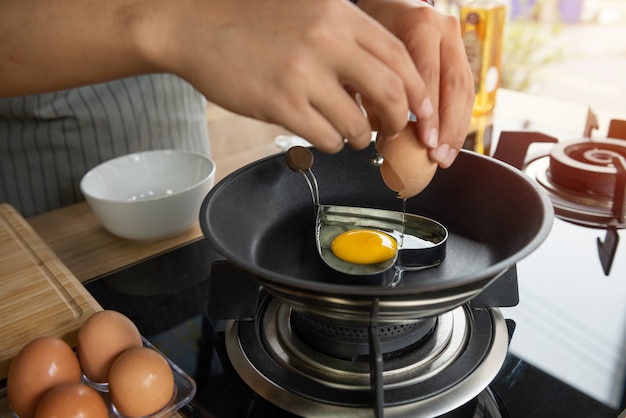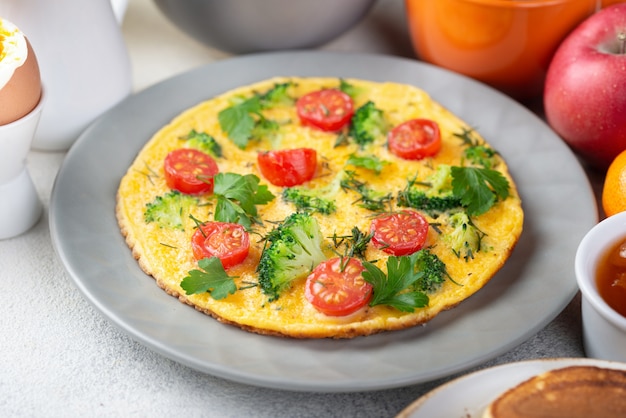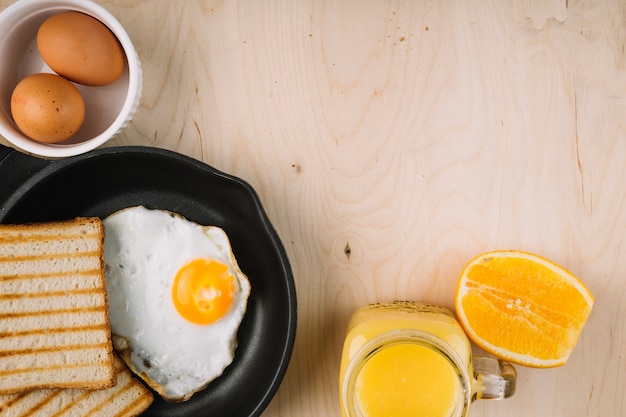Let's face it, a good omelet is a thing of beauty. It's the perfect breakfast, lunch, or even dinner, and it can be as simple or as elaborate as you like. But let’s be honest, those restaurant-worthy omelets with their perfectly golden-brown exterior and fluffy insides can seem impossible to replicate at home.
Well, I’m here to tell you it’s not rocket science. You don't need to be a culinary genius to master the art of the omelet. With a few simple tips and tricks, you can turn out omelets that are as delicious as they are beautiful.
This guide is more than just a recipe. We're going to dive deep into the world of omelets, from the essential tools and techniques to creating your own unique flavour combinations. We'll cover everything from choosing the right pan to mastering the art of the flip. And, of course, we'll explore the endless possibilities for fillings and garnishes.
Ready to transform your breakfast routine into an omelet masterpiece? Let’s get started!
(Part 1) The Omelet Essentials: Mastering the Basics

1. The Holy Grail of Pans
The right pan is the foundation for a perfect omelet. You need something that heats evenly, distributes heat efficiently, and won't stick. Think of it as your omelet's best friend – it's the one that's going to help your creation reach its full potential.
My personal favourite is a cast iron skillet. It’s a bit of an investment, but trust me, it's worth it. Cast iron heats up beautifully and holds the heat, ensuring a consistently cooked omelet. Plus, with proper care, it'll last you a lifetime. Imagine the stories your pan will have to tell when you're a seasoned omelet pro!
If you’re not ready to commit to a cast iron, a good-quality non-stick pan will do the job. Just make sure it’s a sturdy one, not a flimsy, cheap model that will leave your omelet stuck to the bottom.
2. The Art of the Whisk
You might think "whisk, what whisk?" But trust me, a good whisk is a game-changer. You want one that's sturdy enough to incorporate air into your egg mixture, but delicate enough to avoid over-mixing.
My go-to tool is a balloon whisk. It’s got that wide, rounded shape that really works wonders for whipping up those eggs, giving them that fluffy, airy texture that’s essential for a great omelet.
3. The Egg-cellent Eggs
This is where we get to the heart of the matter – the eggs! I always use fresh, high-quality eggs – they make all the difference in the texture and flavour of your omelet.
Don’t be shy about using the yolks! Some people think they make the omelet too oily, but they add flavour and richness that you just can’t get from using only egg whites. Trust me, the extra richness is worth it.
4. The Milk or Cream Factor
Adding a splash of milk or cream to your eggs is a simple trick that elevates your omelet to the next level. It adds moisture, helps prevent the omelet from becoming dry, and contributes to that lovely, fluffy texture.
I usually use whole milk, but you can experiment with different options, like half-and-half or even a little bit of cream for a richer flavour. Just a tablespoon or two will do the trick.
5. Seasoning Secrets
Salt and pepper are the essential seasonings, but don't be afraid to experiment with other spices. Paprika, cayenne pepper, a pinch of nutmeg – let your taste buds guide you!
6. The Filling Frenzy
Here’s where your culinary creativity really shines. The beauty of omelets is that you can create endless flavour combinations. Cheese and ham are classics, but why stop there? Vegetables, meats, seafood, sauces – the possibilities are endless.
(Part 2) The Omelet Masterclass: Techniques for Success

1. The Perfect Omelet Pan Prep
Before you even think about cracking those eggs, make sure your pan is properly prepped. Heat it over medium heat for a minute or two, then add a knob of butter or a drizzle of oil. You want the pan to be hot enough that the butter melts and coats the surface evenly, but not so hot that it starts to smoke.
2. Egg-cellent Egg Whisking
Crack your eggs into a bowl, add a pinch of salt and pepper, and whisk them together until they’re frothy and light. You're essentially incorporating air into the eggs, which will give your omelet that light, airy texture.
3. The Filling Strategy
Before you pour your eggs into the pan, add your desired filling. If you’re using cheese, shred it first – it’ll melt more evenly. If you’re adding vegetables, make sure they’re chopped into bite-sized pieces. You don't want huge chunks of veggies overpowering the delicate egg flavour.
4. The Pouring Technique
Pour your egg mixture into the hot pan and gently tilt it around so that the eggs spread out evenly. You want a thin, even layer of eggs, not a thick, gloopy mess.
5. The Flipping Frenzy
Now, here’s the moment of truth – the flip. This is where most people get nervous, but it's actually quite simple. As the omelet starts to set around the edges, use a spatula to gently lift the edge and fold the omelet in half. You can fold it into thirds for a more elaborate presentation.
6. Cooking to Perfection
Once the omelet is folded, continue cooking it for another minute or two, until it’s set and golden brown on the bottom. You want the inside to be cooked through but still slightly tender.
(Part 3) Omelet Variations: A culinary adventure

1. The Classic Cheese and Ham Omelet
This is the ultimate comfort food omelet – simple, satisfying, and always a crowd-pleaser. Just whisk your eggs, add a generous pinch of salt and pepper, and stir in some shredded cheese and diced ham. Fold the omelet, cook it for a few minutes, and enjoy!
2. The Veggie Fiesta Omelet
For a healthy and flavourful option, load up your omelet with your favourite vegetables. bell peppers, onions, mushrooms, spinach – the possibilities are endless. Sauté your vegetables before adding them to the omelet, or add them raw if you prefer. A little bit of paprika or cayenne pepper adds a nice kick.
3. The Mediterranean Delight Omelet
This omelet is all about fresh, vibrant flavours. Whisk your eggs, add a pinch of salt and pepper, and then stir in some diced tomatoes, feta cheese, olives, and fresh herbs like oregano and basil. It’s a delicious and healthy option for a light lunch or dinner.
4. The Spicy Southwestern Omelet
For a taste of the Southwest, try this spicy omelet. Whisk your eggs, add a pinch of salt and pepper, and then stir in some diced green chiles, jalapeno peppers, onions, and cheddar cheese. Top it off with a dollop of salsa and sour cream for extra flavour.
5. The Seafood Sensation Omelet
If you’re feeling fancy, try adding some seafood to your omelet. Shrimp, scallops, crab, or even smoked salmon are all great options. Sauté your seafood in a little butter or oil before adding it to the omelet.
(Part 4) Omelet Garnishes and Enhancements
1. The Finishing Touches
Once your omelet is cooked, it’s time to add the finishing touches. A sprinkle of fresh herbs, a dollop of sour cream or crème fra??che, or a drizzle of hot sauce can really elevate your omelet from ordinary to extraordinary.
2. The Garnish Game
A sprinkle of fresh parsley, chives, or basil adds a touch of colour and freshness to your omelet. You can also get creative with other garnishes, like chopped tomatoes, grated cheese, or even a few crispy bacon bits.
3. The Sauce Symphony
For a bolder flavour, try drizzling your omelet with a sauce. Aioli, salsa, or even a simple balsamic glaze can take your omelet to the next level.
(Part 5) Omelet Presentation: The Art of Food Styling
1. The Plate Matters
A beautiful plate can really make your omelet shine. Choose a plate that complements the colours and textures of your omelet. For example, a bright yellow omelet will look stunning on a white plate.
2. The Art of Arrangement
Arrange your omelet on the plate with care. You can fold it neatly or leave it open, depending on your preference. A neatly folded omelet looks elegant and classic, while an open omelet allows you to showcase the fillings.
3. The Garnish Placement
Don’t just throw your garnishes on top of the omelet – arrange them strategically. You can create a pattern, scatter them randomly, or even use a small spoon to create little dots of sauce around the omelet.
(Part 6) omelet tips and Tricks: The Insider Secrets
1. Overcooked Omelet Rescue
If your omelet is starting to dry out, add a splash of milk or cream to the pan and let it simmer for a minute or two. This will help to rehydrate the omelet and make it more tender.
2. The Non-Stick Secret
To prevent your omelet from sticking, make sure your pan is properly prepped. Heat it over medium heat for a minute or two, then add a knob of butter or a drizzle of oil. You want the pan to be hot enough that the butter melts and coats the surface evenly, but not so hot that it starts to smoke.
3. The Flipping Fear Factor
Don’t be afraid to flip your omelet. If you’re nervous, you can use two spatulas to lift the omelet and fold it in half. If you’re feeling adventurous, you can flip it with a quick flick of your wrist.
4. The cheese melting Trick
To ensure your cheese melts perfectly, shred it first. If you’re using a block of cheese, grate it using a cheese grater.
5. The Perfect Omelet Consistency
The perfect omelet is cooked through but still slightly tender. You want the inside to be soft and creamy, not rubbery or dry. The edges should be set and slightly browned.
(Part 7) Omelet Variations: Beyond the Basics
1. The French Omelet: A Culinary Masterpiece
The French omelet, or omelette fran??aise, is a classic for a reason. It’s cooked with minimal fuss, resulting in a smooth, silky texture and a slightly runny center. This is the omelet for those who appreciate a more delicate texture and flavour.
2. The Spanish Tortilla: A Savoury Delight
The Spanish tortilla, or tortilla de patatas, is a hearty and satisfying dish that’s perfect for a light lunch or dinner. It’s made with eggs, potatoes, and onions, and it’s often served cold, but it’s also delicious hot.
3. The Japanese Tamagoyaki: A Sweet and Savoury Treat
The Japanese tamagoyaki is a type of rolled omelet that’s a staple in Japanese cuisine. It’s made with eggs, soy sauce, sugar, and mirin, and it’s often served with rice and miso soup. The sweet and savoury flavours of the tamagoyaki make it a truly unique and delicious omelet experience.
(Part 8) The Omelet and Beyond: Culinary Inspiration
1. Omelet Breakfast Burritos
Step up your breakfast game with a delightful omelet breakfast burrito. Simply wrap your favourite omelet filling in a warm tortilla and enjoy.
2. Omelet Pizza
Who says pizza has to be traditional? Get creative with omelet pizza. Spread your omelet on a pizza crust, add your favourite toppings, and bake until the cheese melts and the crust is crispy.
3. Omelet Sandwiches
Omelet sandwiches are a tasty and convenient lunch or dinner option. Simply place your favourite omelet between two slices of bread and enjoy.
FAQs
1. What type of pan is best for making omelets?
You want a pan that’s all about even heat distribution and non-stick qualities. A cast-iron skillet is my personal favourite. If you’re not ready to commit to a cast iron, a good-quality non-stick pan will do the trick.
2. How do you make a fluffy omelet?
The key is to incorporate as much air as possible into the eggs when you’re whisking them together. A balloon whisk is great for this, as it really works wonders for whipping up those eggs.
3. What are some good omelet fillings?
The possibilities are endless! Some popular options include cheese, ham, vegetables, seafood, and sauces. Don’t be afraid to experiment and find your favourite combinations.
4. How do you fold an omelet?
As the omelet starts to set around the edges, use a spatula to gently lift the edge and fold the omelet in half. You can also fold it into thirds for a more elaborate presentation.
5. How do you know when an omelet is cooked?
You want the inside to be cooked through but still slightly tender. The omelet should be set and golden brown on the bottom. If it’s still jiggly in the middle, it needs a few more minutes of cooking.
Everyone is watching

Perfect Rice Every Time: The Ultimate Guide to Cooking Rice
Cooking TipsAs a self-proclaimed foodie, I've always been a bit obsessed with rice. It's the foundation of countless cuisi...

Prime Rib Roast Cooking Time Chart: Per Pound Guide
Cooking TipsPrime rib roast. Just the name conjures images of lavish dinners, crackling fires, and hearty laughter. It’s ...

The Ultimate Guide to Cooking Asparagus: Tips, Techniques, and Recipes
Cooking TipsAsparagus. The mere mention of this spring delicacy conjures up images of vibrant green spears, crisp and burs...

Ultimate Guide to Cooking the Perfect Thanksgiving Turkey
Cooking TipsThanksgiving. Just the word conjures up images of overflowing tables laden with delicious food, the scent of r...

How Long to Bake Potatoes in the Oven (Perfect Every Time)
Cooking TipsBaked potatoes are a staple in my kitchen. They're incredibly versatile, delicious, and surprisingly easy to m...
